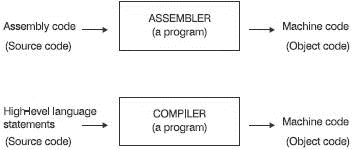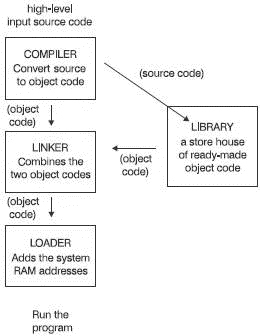Книга: Introduction to Microprocessors and Microcontrollers
Fortran
Fortran
In the early days of computers, they were seen as a means of improving the speed and accuracy of performing mathematical calculations – rather as new and improved calculating machines. IBM dominated the computer world at that time and employed John Backus to produce an improved language to supersede assembly language.
The result, finalized in 1957, was Fortran. This was the first high-level language to gain widespread acceptance. Its claim to fame was that it could evaluate mathematical formulas. This gave rise to its name ‘FORmula TRANslation’ (originally ‘IBM Mathematical Formula Translating System’). (See Figure 10.1.)

Figure 10.1 The first successful high-level language – and still going
Fortran has instructions built-in to handle most scientific formulas such as finding the sine of an angle which would be extremely difficult to do in assembly language. Difficult, but not impossible. After all, the Fortran program must first be converted into the machine code understood by the microprocessor. If the Fortran program can be converted to machine code, then it follows that the program could have been written in machine code in the first case. Its just a matter of saving an enormous amount of work.
As time went by, small additions and alterations were made to the language giving rise to new ‘dialects’. The disadvantage of this is that it starts to erode portability – one of the primary reasons for having a high-level language. In 1958 a re-defined language called Fortran 2 was born which was replaced in turn by Fortran 3 and 4. Still new dialects were sprouting and, in 1966, a final, last, definitive version called Fortran 66 was designed. Then we had the even more final and more definitive Fortran 77 and the absolutely final and totally definitive Fortran 90. This is not as bad as it seems since each new version included extras rather than changes. There was a Fortran 95 version and there is another due out somewhere around the year 2004 to 2006 which, at the moment, is just referred to as 200X but at least this name suggests a launch no later than the year 2009. In the meantime, an easily learnt version, simply called F, was launched. This was compatible with Fortran 77, 90 and 95 but includes some more modern characteristics while older more redundant sections were quietly dropped. High Performance Fortran (HPF) is similar to the 90 and 95 versions except that it has been extended to allow microprocessors to be run in parallel for extra speed.
Compilers
In assembly language, we used an assembler program to convert the mnemonics to machine code. We usually refer to the conversions being from source code to object code but it means the same thing. In Fortran, or any high-level language, we use a compiler to produce the machine code. The compiler will also carry out the useful extras like error and syntax checking that we met with the assemblers. Compilers and assemblers are both software – that is, they are programs designed to do a specific job. If we were using a 68000 microprocessor, and wished to program it using a particular language, say Fortran, then we would have to purchase a ‘Fortran 90 to 68000’ compiler. It would do just this job and nothing else. We could not adapt it in any way to accept a different high-level language or ‘target’ it at a different processor (see Figure 10.2).

Figure 10.2 Compilers are like assemblers
All assemblers are basically one-to-one converters. We enter the op code and out comes the object code so the only difference between two assemblers is in the amount of debugging and label handling help that it can provide. Compilers are different. There are not any direct object code equivalents to things like sine or square root so the final output depends on the skills of the compiler designer. The programmer must look at each of the available commands in the high level language and write an assembly program to perform the function. Some compilers are, therefore, inevitably better than others.
Libraries, linkers and loaders
When the designer has struggled through the process of devising assembly code for a particularly nasty formula it would make sense to store the answer away to allow its use on another occasion. A collection of these solutions is called a library and can be purchased.
This reduces the amount of totally original coding that is needed. Many ‘new’ formulas can be made from combinations of existing code. Slotting these ready-made library routines into the main programs is performed by a linker which is another piece of software. The linker therefore joins or links together many separate pieces of code into one program ready for use. The last job to be done is to load it into some RAM ready for use. Another piece of software is used to determine which addresses in the microprocessor system memory are available. This is called a loader. A loader also converts labels to their final addresses. Very often the linking and loading functions are combined into a single linker-loader program. The process is illustrated in Figure 10.3.

Figure 10.3 From high level to low level
Fortran source code
Fortran consists of numbered statements called program lines and are used to tell the system the order in which the instructions are to be carried out. In the absence of any other commands, the program lines are executed in numerical order.
Fortran code is written in a very compact form much closer to mathematics than English. For example, to load a number and find the square root of it may look like this:
1 Read (4) P
2 A = SQRT(P)
In statement 1, the microprocessor is sent to input number 4 (this must be defined earlier) and retrieves a number which we call P. Statement 2 finds its square root.
Fortran has accumulated enormous libraries to handle scientific and engineering problems. The drawback of Fortran is that its instructions are so very compact that, unless you are happy with formulas, it can look a little frightening. In addition, its format is very precise and this makes it difficult and unforgiving to learn. If you have a morbid dread of mathematics, you may find its approach a little daunting.




